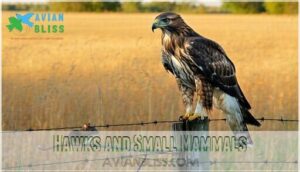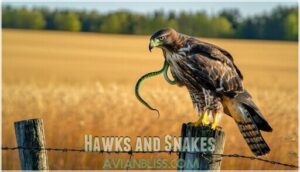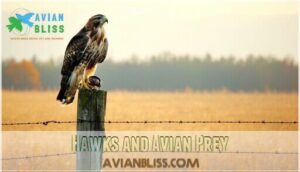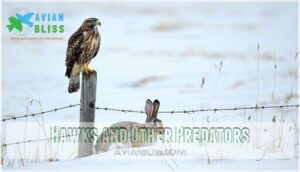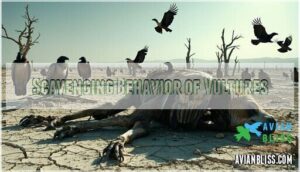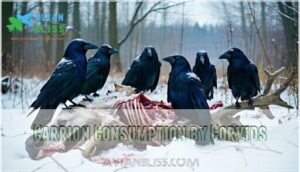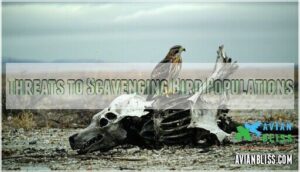This site is supported by our readers. We may earn a commission, at no cost to you, if you purchase through links.
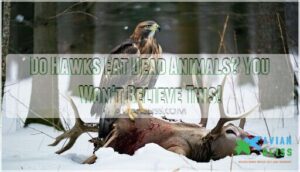 You might be surprised to learn that hawks aren’t just skilled hunters – they’re also opportunistic scavengers!
You might be surprised to learn that hawks aren’t just skilled hunters – they’re also opportunistic scavengers!
While they prefer catching live prey, hawks won’t turn down a free meal of dead animals when hunting gets tough.
These adaptable predators will gladly eat carrion, especially during winter or when food is scarce.
Their sharp beaks and powerful digestive systems allow them to safely consume decaying flesh, helping clean up ecosystems in the process.
Different hawk species vary in how often they’ll munch on dead animals, but most will grab an easy meal when the chance presents itself. Think of them as nature’s resourceful cleanup crew.
Table Of Contents
- Key Takeaways
- Scavenging Behavior of Hawks
- Hawks and Small Mammals
- Hawks and Snakes
- Hawks and Avian Prey
- Hawks and Other Predators
- Hawks in Urban Environments
- Scavenging Behavior of Vultures
- Other Scavenging Birds
- Carrion Consumption by Corvids
- Threats to Scavenging Bird Populations
- Frequently Asked Questions (FAQs)
- Conclusion
Key Takeaways
- You’ll discover hawks aren’t just predators – they’re opportunistic scavengers who’ll readily consume carrion when live prey is scarce, using their powerful digestive systems to safely process decaying flesh.
- Different hawk species vary in their scavenging habits, but most will take advantage of roadkill or dead animals, especially during challenging seasons like winter when hunting becomes difficult.
- Hawks have remarkable anatomical adaptations that enable them to eat dead animals, including strong stomach acids that neutralize bacteria and sharp beaks that can tear through tough carcasses.
- By consuming carrion, hawks play a critical role in ecosystem cleanup, helping to prevent disease transmission and supporting nutrient cycling in their environments, making them nature’s resourceful cleanup crew.
Scavenging Behavior of Hawks
You’ll discover that hawks are quite the clean-up crew, often taking advantage of a free meal.
They’ve some amazing adaptations that help them eat things that might make you wrinkle your nose.
Opportunistic Feeding on Carrion
You’ll discover that hawks are, fundamentally, hawk opportunistic feeders, readily embracing carrion when live prey is scarce.
Hawks eating carrion is a survival strategy.
Their Roadkill Preference and Predator Following are key.
During Scavenging Seasons, they gain Carrion Nutrients.
This opportunistic feeding contributes to Disease Resistance.
The hawk carrion diet is a demonstration of their adaptability.
Adaptations for Consuming Decaying Flesh
Your hawk’s ability to consume carrion is fascinating! The anatomical adaptations are key to their hawk scavenging behavior.
Let’s explore how hawks eat corpses:
- Bacterial Resistance: Hawks’ Digestive System is built to handle bacteria.
- Beak Morphology: Beak Morphology allows tearing.
- Talon Strength: Talon Strength helps with carrion handling.
- Nutritional Extraction: Efficient Nutritional Extraction from decaying flesh.
These anatomical adaptations allow hawks to safely and effectively consume carrion.
Hawks have a specialized system for digesting carrion safely.
Role in Ecosystem Cleanup and Disease Prevention
Now that we’ve covered how hawks handle decaying flesh, let’s explore their role in the environment. You’ll be amazed!
Hawks’ scavenging behavior helps maintain ecosystem balance and protects public health.
- They stop disease transmission.
- They aid in carcass decomposition.
- They prevent disease spread.
- They contribute to nutrient cycling.
- Hawks consume carrion, supporting ecosystem cleanup and disease prevention.
Prevalence of Scavenging in Different Hawk Species
Now you’re curious about how often hawks scavenge. Let’s explore the prevalence of scavenging in different hawk species.
Scavenging frequency varies. Red-tailed hawks readily hawk consume carrion. Other species show differences.
| Factor | Impact on Scavenging | Examples |
|---|---|---|
| Regional Differences | Variable | Food availability in different areas. |
| Seasonal Shifts | Changes | More carrion in winter. |
| Species Variations | Diverse | Red-tails vs. other hawk scavenger bird. |
Hawks and Small Mammals
You’ll find that hawks depend on small mammals like mice and rabbits for food. They’re experts at hunting these creatures, but sometimes they’ll eat dead ones too.
Rodents as Primary Prey
In the sphere of hawks, you’ll find rodents are a top choice. They’re a key part of a hawk’s diet. These birds use various Rodent Hunting Techniques to catch their meals.
- Mice and voles are often on the menu.
- Hawks help control Rodent Population Impact.
- Hawk Hunting Success relies on this food source.
- Hawks prefer fresh meat, but sometimes they’ll hawk eat corpses.
Hawks have specific Prey Preference Factors, making rodents a primary part of their hawk food sources and hawk prey animals.
They aren’t picky eaters. Different species of hawks, like the Ferruginous Hawk, adapt to their environment and use various hunting strategies to catch their prey. Rodent Consumption Methods vary.
Hunting Techniques for Small Mammal Prey
If you’re wondering how hawks catch their small mammal prey, you’ll find it’s all about strategy.
Hawks use several hawk hunting techniques. The Perching Method, Soaring Technique, and Hovering Strategy are key.
These hawk hunting techniques, combined with Efficient Hunting, are all about Energy Conservation.
Hawks’ hawk hunting style is optimized for success. Hawks utilize various hunting strategies for prey to maximize their hunting success.
Importance of Small Mammals in Hawk Diet
Considering the hawk diet, you’ll discover the important role of small mammals. Hawks eat dead animals, but their Mammal Prey Preference is clear.
- They’re a primary food source.
- Hunting Strategies are fine-tuned for success.
- Prey Abundance Impact fuels their survival.
- The high Nutritional Value supports them.
These factors influence Population Dynamics, making small mammals important to the hawk diet, even when hawks eat dead animals as carrion.
Hawks and Snakes
You might be surprised to learn that hawks often hunt snakes for a meal. These skilled hunters take advantage of open spaces to spot and capture their slithering prey.
Hawks as Snake Predators
Hawks frequently engage in snake hunting techniques. They’re skilled snake predators, and their hawk predator diet includes snakes. You might be surprised by their snake prey selection!
Here’s how hawks hunt snakes:
- Silent swooping attacks
- Strategic head strikes
- Precise talon placement
- Quick kills with their beak
Hawk-snake interactions are common, and these birds have adapted to snake consumption methods. They aren’t afraid of dead animals.
Advantages of Open Habitats for Hunting Snakes
With open habitat benefits, you’ll see how hawk hunting strategies thrive.
Open habitats maximize snake visibility, important for prey pursuit.
Hawks, as snake predators, use this to their advantage.
This terrain boosts hawk predator diet efficiency. **They can spot snakes easily.
Their hawk eating habits and hunting strategies are finely tuned.
Predator avoidance is key, making open habitats ideal.
Interspecific Conflicts Between Hawks and Snakes
The drama of the wild unfolds in the Hawk-Snake Competition. Hawks and snakes clash, revealing the raw predator prey dynamics.
- Hawk Hunting Tactics
- Snake Defense Strategies
- Habitat Overlap
- Prey Resource Sharing
These hawk snake conflicts highlight hawk eating habits, including consuming dead animals, and the constant struggle for survival.
Hawks use their sharp talons and beaks for capturing and dispatching prey.
Hawks and Avian Prey
You might be surprised to learn that some hawks are actually bird hunters, focusing their efforts on other feathered friends.
We’ll explore the clever ways these hawks catch their avian prey and how this impacts the birds in your own backyard.
Hawks That Specialize in Hunting Birds
Building on the understanding of hawk diets, let’s explore the practice of bird hunting. Many hawks, known as birds of prey, specialize in catching other birds.
- Cooper’s Hawks are masters of aerial ambushes.
- Sharp-shinned Hawks excel in speed and precision.
- Northern Goshawks take down larger avian prey.
- Peregrine Falcons are the ultimate high-speed hunters.
These hunting adaptations showcase diverse bird hunting techniques, influenced by habitat influences and avian prey preferences.
These hunters face threats to birds but still thrive.
Their diet includes carrion when needed.
Strategies for Catching Smaller Bird Species
Now that we’ve explored hawks specializing in hunting birds, let’s look at how they catch them.
Hawks are masters of prey selection, using several strategies.
They employ soaring techniques and ambush tactics.
| Attack Type | Description |
|---|---|
| Mid-Air Attacks | Target smaller birds. |
| Low Flight | Used in pursuit. |
| Talon Tactics | Grabbing prey. |
| Opportunistic Diet | Hawk scavenging behavior is important. |
They prioritize energy conservation and their opportunistic diet, even eating dead animals.
Risks to Backyard Birds From Hawks
Backyard bird-watching can become a high-stakes game when hawks are around.
Understanding predator identification is key.
Hawks, skilled hunters, see your backyard as a potential hunting ground.
Your small birds are their prey.
Enhance bird feeder safety by placing feeders near dense cover.
Consider habitat modification and use hawk deterrents.
Protect your pet bird protection by keeping them indoors during peak hawks‘ hunting hours.
Hawks, though they eat dead animals sometimes, are primarily focused on live prey in your backyard.
Their hunting skills are unmatched.
For those interested in solutions, explore hawk bird feeder options to help protect your birds.
Hawks and Other Predators
You’ll learn about the complex relationships hawks have with other predators in the wild. We’ll examine how hawks interact with owls, foxes, and even waterfowl for food and survival.
Predatory Interactions Between Hawks and Owls
Since owls and hawks share habitat, you’ll witness a predator-prey dynamic. Hawk-Owl competition is common, especially during opportunistic hunting.
- Great Horned Owls prey on Red-tailed Hawks.
- Owl Hunting Strategies include nocturnal attacks.
- Hawk-Owl Conflicts arise from habitat overlap and hawk diet.
Nocturnal Hunting separates them, yet carrion consumption by hawks rarely triggers fights, promoting raptor coexistence.
Hawks as Predators of Foxes and Other Small Carnivores
Now, let’s shift gears. Hawks are fierce predators, and sometimes their targets are other carnivores! You might be surprised, but they do engage in Fox Hunting Strategies.
Here’s what you should know:
- Hawks hunt older fox cubs.
- They occasionally target adult foxes.
- Hawks eat dead animals, including carnivores, as carrion.
Understanding Predator-Prey Dynamics helps explain Hawk-Carnivore Competition. Carnivore Prey Preferences influence the Carnivore Population Impact.
Hawks as Predators of Waterfowl
Beyond their scavenging habits, hawks are formidable hunters, particularly regarding waterfowl.
They engage in waterfowl hunting, with duckling predation being a key strategy.
Hawks, as predators, launch goose attacks and target young waterfowl.
The habitat impact is significant.
Hawks eat dead animals, but waterfowl hunting is a priority. Their predator strategies include aerial ambushes.
Hawks in Urban Environments
You’ll find hawks are surprisingly adaptable creatures, even in cities. They’ve learned to thrive in these environments by taking advantage of the food sources available.
Adaptation to Prey on Urban Rodents and Birds
Adaptable urban hawks transform city landscapes into hunting grounds, turning concrete jungles into their personal hunting playgrounds.
Witnessing urban hawks’ urban hunting strategies is fascinating.
Hawks adapt brilliantly to city life, turning urban landscapes into their personal hunting grounds.
Adapting to city nesting, they target rodents and birds.
Prey density drives their opportunistic diet, including carrion consumption.
These hawks eat dead animals, showcasing their adaptations to habitat alterations.
Human impact influences their success, making urban scavenging a key survival tactic.
Threats to Domestic Pets
To guarantee pet protection, especially in urban areas, you should know the risks.
Because of their size, hawks eat dead animals, and your pet’s size matters.
Pet Safety is important, so supervise your pets.
Predators like hawks pose a threat, so learn about predator risks to pets.
Your pet’s location and pet size influence the chances of Hawk Attacks.
Small pets are more vulnerable.
Remember, hawks view pets as potential prey.
Attracting Hawks to Backyard Habitats
After addressing the risks to pets, let’s explore how to welcome these majestic birds.
You can create Hawk-Friendly Habitats right in your backyard. This supports their scavenging habits, including when hawks eat dead animals or carrion.
Hawks often choose areas with abundant prey sources to hunt for food.
Here’s how:
- Perch Placement.
- Water Sources.
- Prey Attraction.
- Habitat Design.
- Provide a safe habitat.
Scavenging Behavior of Vultures
Vultures are equipped with unique adaptations like strong stomach acid and bald heads, making them perfectly suited for eating carrion.
Their scavenging habits play a critical role in preventing the spread of disease and keeping ecosystems clean.
Anatomical Adaptations for Consuming Carrion
Hawks might surprise you with their adaptations for eating carrion, or animal remains.
Their strong beaks and sharp talons make tearing flesh easy, while powerful stomach acids break down decaying meat safely.
Hawks rely on their:
- Strong digestive enzymes to process carrion.
- Hooked beaks for efficient tearing.
- Acidic guts to handle pathogens.
- Feather hygiene to prevent contamination.
Role in Disease Prevention and Ecosystem Cleanup
Vultures play a powerful part in ecosystem cleanup by tackling carrion–often nature’s waste pile.
Their scavenging cuts down Disease Transmission risks, helping Public Health.
Think of them as nature’s janitors, recycling nutrients through Nutrient Cycling while restoring Ecosystem Balance.
Here’s a quick view of their contributions:
| Role | Benefit | Impact |
|---|---|---|
| Waste Removal | Cleaner habitats | Supports wildlife |
| Disease Prevention | Limits pathogens | Protects biodiversity |
| Nutrient Cycling | Enriches soil | Boosts vegetation |
Threats to Vulture Populations
Vultures, nature’s cleanup crew, are in serious trouble.
Habitat destruction, human persecution, and poisoning risks leave them battling extinction.
Contaminated carcasses—laced with pesticides or lead—are one of the deadliest traps.
Poachers, driven by myths of magical cures, hunt them for traditional medicine, making survival even tougher.
Climate change worsens food scarcity, forcing these resilient scavengers to scrounge harder for carrion.
- Top threats: Poisoned carrion, shrinking habitats, and human actions.
Without vultures preventing disease outbreaks, ecosystems suffer.
It’s a grim reminder of how important scavengers are, including hawks that eat dead animals.
Other Scavenging Birds
You might be surprised to learn that hawks aren’t the only birds that scavenge for food.
From the bold crested caracaras to the majestic bald eagles, many scavengers rely on carrion to survive and play important roles in their ecosystems.
Crested Caracaras as Opportunistic Scavengers
A bold carnivore of the grasslands, the crested caracara turns nature’s leftovers into a survival feast.
Crested caracaras, often mistaken for hawks, thrive as opportunistic feeders.
Crested caracaras boldly survive by turning nature’s leftovers into their ultimate survival strategy.
Their scavenging adaptations allow them to boldly consume carrion and dead animals in diverse habitats, from grasslands to urban areas.
Unlike the typical hawk diet, the caracara diet leans heavily on scavenging.
Their curious nature and clever tactics, like following predators for leftovers, make them fascinating survivors in nature’s cleanup crew.
Bald Eagles as Carrion Consumers
Scavenging isn’t just for vultures—bald eagles embrace it with ease!
These majestic birds flex their scavenging adaptations, thriving even in harsh winters by feeding on carrion.
Their ability to consume dead animals supports survival and showcases their role in the ecosystem.
Here’s what makes them expert scavengers:
- They use powerful hooked beaks to tear tough carcasses like roadkill.
- Bald eagles happily share carrion with other scavengers.
- Their scavenging strategies complement hunting skills during food scarcity.
- Roadkill consumption keeps them energized without exhausting resources.
These birds are a demonstration of conservation success stories, rebounding from near extinction.
Adaptability keeps bald eagles soaring strong—both hunters and foragers!
Marabou Storks and Their Scavenging Habits
After witnessing bald eagles dominate carrion scenes, prepare to meet Africa’s unsung scavengers: marabou storks.
These massive birds patrol landfills and nesting sites, wielding powerful beaks that slice through carcasses other scavengers can’t touch.
With remarkable stork diet diversity and opportunistic nature, they’re nature’s cleanup crew, transforming dead animals into ecosystem maintenance.
Carrion Consumption by Corvids
You might be surprised to learn that corvids, like crows and jackdaws, are nature’s ultimate opportunistic scavengers.
Their remarkable adaptability allows them to consume carrion across diverse ecosystems, playing a key role in maintaining environmental balance and cleaning up organic waste.
Carrion Crows as Adaptable Scavengers
These crafty carrion crows showcase remarkable urban scavenging prowess, using their Corvid intelligence to excel at opportunistic feeding.
Their dietary flexibility allows them to navigate complex feeding behaviors across diverse habitats, efficiently consuming dead animals through sophisticated scavenging strategies.
By working together in groups, these adaptable birds play an important role in ecosystem maintenance, transforming potential waste into a collective survival mechanism.
Eurasian Jackdaws and Their Scavenging Behavior
These intelligent corvids have mastered urban survival through clever scavenging strategies. Eurasian jackdaws are nature’s urban opportunists, transforming cityscapes into buffet zones with their remarkable adaptability.
- They leverage group intelligence to discover hidden carrion sources
- Small bodies allow access to tight spaces other scavengers can’t reach
- Cooperative hunting maximizes their chances of finding food
Their jackdaw diet reveals a sophisticated approach to carrion selection, proving these birds are more than just feathered street survivors. By working together, they turn urban environments into thriving foraging grounds.
Seabird Scavengers and Their Role in Marine Ecosystems
When you scan coastal landscapes, seabirds emerge as nature’s marine cleanup champions.
These feathered recyclers perform a remarkable service by:
- Transforming decaying matter into marine ecosystem nutrients
- Preventing disease spread through rapid carcass removal
- Managing fishery waste efficiently
- Supporting coastal habitat balance
Marine food webs depend on seabird scavengers’ incredible adaptations.
From gulls to petrels, these birds navigate complex marine ecosystems, consuming carrion and maintaining delicate environmental equilibrium.
Their unique scavenging skills guarantee that no marine resource goes to waste, highlighting their indispensable role in ocean health.
Threats to Scavenging Bird Populations
You mightn’t realize the challenges that scavenging birds face in today’s rapidly changing world.
From habitat destruction to human interference, these critical ecosystem players are struggling to survive and maintain their essential role in nature’s delicate balance.
Habitat Loss and The Impact on Scavengers
Habitat destruction and wildlife disruption create a domino effect for hawk survival.
When landscapes crumble, these remarkable scavengers face mounting challenges in finding food and shelter.
| Impact | Consequence | Outcome |
|---|---|---|
| Habitat Loss | Reduced Prey | Survival Risk |
| Fragmentation | Food Scarcity | Ecosystem Strain |
| Destruction | Disease Exposure | Population Decline |
Conservation strategies become critical in protecting these essential carrion consumers and maintaining delicate ecological balances.
Persecution and The Traditional Medicine Trade
Hawks face a grim reality beyond habitat loss. Illegal poaching and traditional medicine trades threaten these remarkable scavengers. Their survival hangs in the balance as cultural beliefs drive harmful practices.
- Traditional medicine demands drive illegal wildlife trade
- Hawk populations suffer from human persecution
- Conservation efforts aim to protect these critical ecosystem guardians
Human actions directly impact these remarkable birds’ existence, challenging their right to survive and thrive.
Conservation Efforts to Protect Scavenging Birds
By joining hands with local conservation groups, you can make a real difference in protecting scavenging birds.
Focus on critical strategies like habitat preservation, reducing lead poisoning risks, and supporting legal protections for carrion-consuming species.
Monitoring populations helps track their health and challenges.
Public education plays a key role in raising awareness about these ecosystem cleaners.
Support wildlife sanctuaries, participate in conservation efforts, and spread the word about the importance of scavengers.
Your involvement can help these remarkable birds continue their essential work of maintaining ecological balance.
Frequently Asked Questions (FAQs)
Do hawks eat dead animals?
Imagine a wild hunter’s survival strategy!
You’ll discover hawks aren’t just fierce predators—they’re opportunistic survivors.
When live prey vanishes, they’ll gladly feast on roadkill, carrion, and abandoned carcasses, ensuring their survival in nature’s challenging landscape.
Do Hawks scavenge dead animals?
You’ll find hawks are opportunistic scavengers who readily consume dead animals.
They’ll feast on roadkill, carcasses left by other predators, and carrion when live prey is scarce, using their sharp talons and strong stomach acid.
Are Hawks carnivores?
Yes, hawks are fierce carnivores!
They’ll hunt and devour small mammals, birds, and reptiles with razor-sharp precision.
Their diet consists exclusively of meat, making them pure predators who rely on their incredible hunting skills to survive.
Do hawks eat meat?
Sharp talons, keen eyes, and razor-sharp beaks tell a story – hawks devour meat with gusto.
You’ll find these predators feasting on live prey and carrion, consuming everything from tiny rodents to larger game with incredible efficiency.
Do hawks eat bears?
Hawks don’t typically eat bears.
These raptors prey on much smaller animals like rodents, small birds, and insects.
A bear’s massive size and strength make it an impossible target for even the largest hawk species.
Can a hawk eat a whole day?
You’ll be amazed that a hawk can devour prey weighing up to 15% of its body weight daily.
They’ll hunt multiple times, often consuming smaller meals throughout the day to maintain their energy and survive in the wild.
How do hawks eat?
Imagine a feathered ninja swooping down!
You’ll tear prey with razor-sharp talons, swallowing small animals whole or ripping larger ones into bite-sized pieces, ensuring every morsel fuels your sky-high hunting adventures.
Why do hawks eat insects?
You’ll catch insects because they’re an easy protein source when other prey is scarce.
These tiny meals help smaller hawks survive, providing quick nutrition during lean hunting periods when larger game isn’t available.
Do hawks eat animals that are already dead?
You’ll find these predatory birds aren’t picky eaters!
They often scavenge dead animals, especially during winter when hunting gets tough.
Roadkill, carrion from other predators, and deceased prey become easy meals to help them survive.
Can a hawk pick up a 10 pound cat?
Like a stealthy predator prowling the skies, some hawks might snatch a 10-pound cat, but it’s rare.
Larger hawks like red-tailed hawks could potentially lift smaller cats, though they typically target prey under 5 pounds.
Conclusion
Symbolically soaring through nature’s complex food web, hawks reveal themselves as master survivors.
You’ll discover these remarkable birds aren’t just fierce predators, but adaptable scavengers who eat dead animals when survival demands.
Whether hunting live prey or consuming carrion, hawks play a key ecological role that might surprise you.
Their ability to consume decaying flesh demonstrates remarkable resilience, proving that in the wild, opportunity trumps preference every time.
- https://theraptortrust.org/bird-resources/bird-facts/hawk-facts/
- https://www.thespruce.com/carnivorous-diet-definition-386866
- https://www.allaboutbirds.org/guide/browse/shape/Hawks%20and%20Falcons
- https://en.wikipedia.org/wiki/Hawk
- https://wagwalking.com/wellness/how-to-protect-your-small-dog-from-hawks

